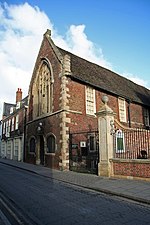Skirbeck
Boston, LincolnshireFormer civil parishes in LincolnshireOpenDomesdayUse British English from December 2013Villages in Lincolnshire

Skirbeck is a suburb and former civil parish in the Borough of Boston in the county of Lincolnshire, England. Skirbeck is a long v-shaped formation wrapped around the south and east side of Boston parish. It has been incorporated into the Borough of Boston since 1932. It is in the Skirbeck ward of the Boston Borough Council. Skirbeck includes the hamlet and former civil parish of Skirbeck Quarter which was on the west side of the River Witham and was a separate parish from 1866 to 1932.
Excerpt from the Wikipedia article Skirbeck (License: CC BY-SA 3.0, Authors, Images).Skirbeck
Fishtoft Road,
Geographical coordinates (GPS) Address Nearby Places Show on map
Geographical coordinates (GPS)
| Latitude | Longitude |
|---|---|
| N 52.97 ° | E -0.01 ° |
Address
Ann's Fish and Chips
Fishtoft Road 56a
PE21 0AL , Skirbeck
England, United Kingdom
Open on Google Maps









